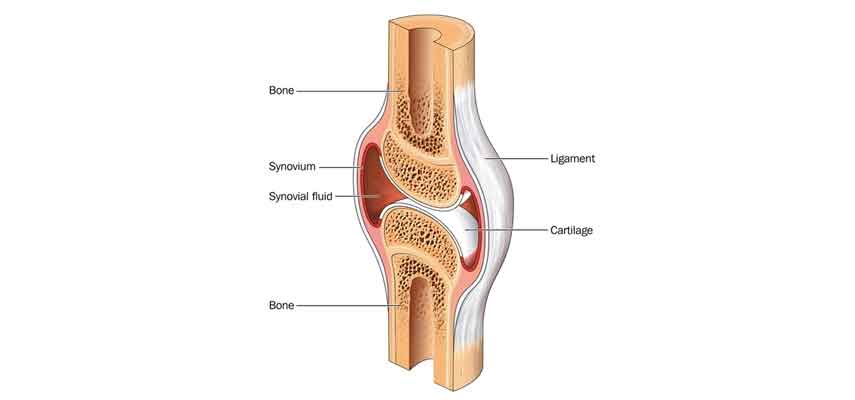Joint pain is usually associated with arthritis and millions of people in the United States suffer from this problem. According to Centers for Disease Control and Prevention about 52.5 million adults in the United States reported being told by their doctor that they have some form of arthritis. More precisely, one in five people in the US (about 22.5%) have doctor-diagnosed arthritis and it is estimated that by 2030, about 67 million Americans will be diagnosed with arthritis as well. Arthritis, regardless of the type (because there are more than 100 types of disease) has joint cartilage damage as one of its causes. But, what is joint cartilage, exactly? In order to find out what is it, and how you can treat it, keep reading this article.
What is Joint Cartilage?
Cartilage is an important structural component of the body. It’s a firm tissue, but it’s also softer and more flexible than the bone. Basically, cartilage is a connective tissue that is found in many areas of your body, including:
- Joints between bones e.g. knees, ankles, elbows
- Ends of the ribs
- Between the vertebrae in the spine
- Ears and nose
- Bronchial tubes or airways
The cartilage between the joints is known as articular cartilage and it belongs to type of cartilage that is called hyaline cartilage. It is springy and tough at the same time. Hyaline cartilage consists of a slimy mass of a firm consistency. However, it’s extremely elastic and has a pearly bluish color.
The primary role of joint cartilage is to make sure your joints move smoothly and easily. However, unlike some other types of tissue in your body, cartilage doesn’t have a blood supply. Blood cells help repair tissue damage by diffusion. Therefore, once cartilage gets damage it takes much longer to heal, comparing to tissues in your body that have blood supply.
A lifetime of exercising, walking and moving takes toll on joint cartilage. As it was mentioned above it is prone to damage that won’t heal easily. Joint cartilage damage can induce severe pain, inflammation, and in some cases even some degree of disability. Damage of joint cartilage is quite common, especially in the knee. For example, according to the National Institutes of Health, one third of the US adults aged over 45 suffer from knee pain.
Causes of Joint Cartilage Damage
There are several causes of joint cartilage damage, such as:
- Direct blow – if a joint receives a devastating impact the cartilage may damage as well. This can happen due to numerous reasons like car accident, fall, being hit by a ball etc. Athletes are usually exposed to this cause of joint cartilage damage.
- Wear and Tear – sustained stress on the joint over a longer period of time may eventually take its toll. For example, being overweight puts a larger pressure on your joint which eventually damages cartilage and induces pain.
- Lack of movement – in order to remain healthy, your joints need to move regularly. Prolonged periods of inactivity can cause significant damage to joint cartilage.
Symptoms of Joint Cartilage Damage
People with damage of joint cartilage may experience these symptoms:
- Inflammation – This is the most frequent way our body responds to irritation or injury. The affected area swells, becomes warmer than other body parts, and it’s also tender, sore and painful.
- Joint Stiffness
- Range limitation – As the damage progresses, the range of movement decreases. For example, if you have a damage of joint cartilage in your knee you may experience you can’t walk as much as you used to or you can’t jog anymore because your knee suffers severe pain.
NOTE: If the affected area is blotchy or bruised and you experience unbearable pain it may be a symptom of piece of joint cartilage being broken, which “locks” the joint.
Although joint cartilage damage usually occurs in your knee other areas such as hip, elbow, wrist, ankle, or shoulders can be affected too.
How to Strengthen Joint Cartilage?
If damaged joint cartilage is left untreated it can induce severe consequences on affected joint. In order to ensure its functionality and to avoid more serious problems, there are some things you can do to make it stronger. They are listed below:
Medication
Your doctor will usually prescribe some medications that will help you relieve the pain. However, if the pain isn’t unbearable then you can use some over-the-counter medications or supplements as well. For example, Projoint Plus joint pain supplement protects, strengthens, and improves the range of motions for your joints. The product is formulated from natural ingredients such as:
- Glucosamine sulfate
- Chondroitin sulfate
- Hyaluronic acid
- Bromelain, and many others
The most important benefits of Projoint Plus include:
- Improved lubrication of joints
- Reduced joint inflammation
- Minimized joint pain
- Strengthened joint cartilage
- Increased ease in joint movements
Exercise
When it comes to joint pain or even damaged joint cartilage, people usually assume that avoiding any type of physical activity is a good thing to do, however, that isn’t beneficial for the affected joint. Instead, doctors recommend doing various low-impact exercises that would improve your mobility. However, you have to know when to stop and have some rest. For example, whenever you feel like you have no strength anymore to keep up with the same tempo, stop and sit down. Exercising through the pain can only aggravate the pain.
Weight loss
Being overweight or obese puts a greater pressure on your joints which results with more severe pain. In order to strengthen your joint cartilages and to avoid severe joint pain, you should strive to lose weight.
Injections
Injections belong to conservative treatment of damage in joint cartilage and your health care provider usually inserts hyaluronic acid or corticosteroids into affected joint.
Heat/cold therapy
Apply warm compresses or ice packs onto affected areas whenever you feel like your joints are sore or painful. This relieves the pain and prevents inflammation.
Conclusion
Joint cartilage is a connective tissue that allows our joints and bones to move easily, however it is prone to damage but due to lack of blood supple it may last longer for it to recover. However, there are some things you can do to strengthen your joint cartilage such as taking supplements or medications, doing low-impact exercises etc. Make sure you see your health care provider when you experience symptoms of joint cartilage damage as ignoring the problem can only lead to more severe consequences.







 This article changed my life!
This article changed my life! This article was informative.
This article was informative. I have a medical question.
I have a medical question.
 This article contains incorrect information.
This article contains incorrect information. This article doesn’t have the information I’m looking for.
This article doesn’t have the information I’m looking for.